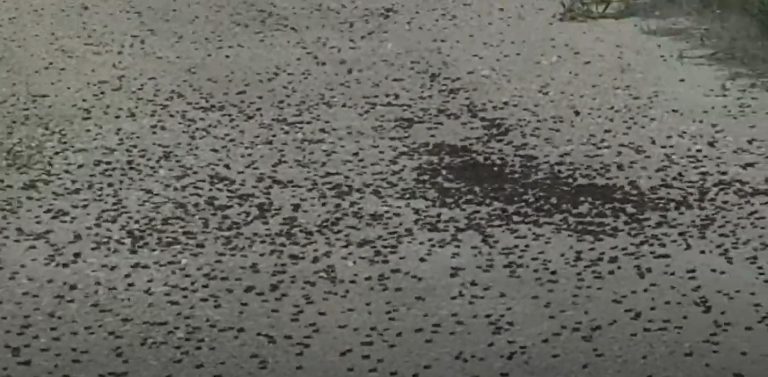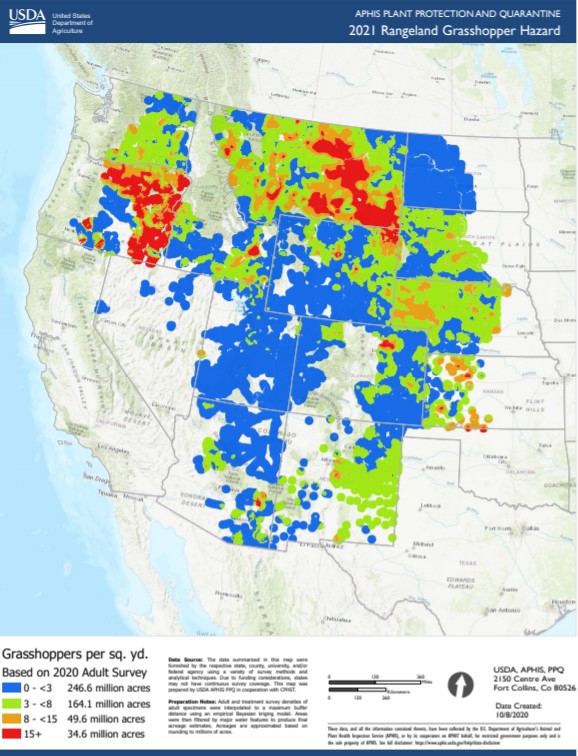

Posted on 07/08/2021 3:25:29 PM PDT by Roman_War_Criminal
A massive population of grasshoppers is proliferating in the sweltering American west, where a deep drought has made for ideal conditions for grasshopper eggs to hatch and survive into adulthood.
“I can only describe grasshoppers in expletives,” said Richard Nicholson, a cattle rancher in Fort Klamath, a small community in southern Oregon, who once recalled seeing grasshopper bands eat 1,000 acres a day and cover the ground like snow.
The insects cause innumerable headaches for farmers and ranchers, competing with cattle for tough-to-find wild forage and costing tens of thousands of dollars in lost crops and associated costs. “They are a scourge of the Earth … They just destroy the land, destroy the crops. They are just a bad, bad predator.”
Prolific though they are, the grasshoppers are not interlopers. Native to the western lands, they have been there for millions of years, their populations typically in check.
They hatch as tiny versions of adults, so small about 50 can fit on a coin the size of a quarter. In average years, most die off before becoming the winged grownups that now buzz the rural skies. They and their eggs are susceptible to pathogens, brutal winters and starvation while young.
But grasshopper populations began ballooning in spring 2020, thanks to warmer and drier winters that favored survival, along with a lucky few rains that spur grass that feeds young grasshopper populations.
Oregon and Montana have been the hardest hit by the insatiable eaters, particularly in the arid eastern flank of both states. Thirteen other states are also facing grasshopper damage, according to hazard maps assembled by the animal and plant health inspection service at the US Department of Agriculture.
The program helps contain grasshoppers on rangeland and also targets a close cousin, the Mormon cricket. The 17 states under the purview of this pest patrol have a combined agricultural value of $8.7bn, according to the most recent estimates. Last year the program spent more than $5m on suppression efforts and is presently steeped in more.
“The biggest biomass consumer in the country are not cattle, are not bison. They are grasshoppers,” said Helmuth Rogg, an entomologist and agricultural scientist who works for the Oregon department of agriculture. “They eat and eat from the day they get born until the day they die. That’s all they do.”
“They basically ate all the forage,” said John O’Keeffe, a cattle rancher whose eastern Oregon ranch was besieged by grasshoppers a year ago. The ranch was recently treated with insecticide to avoid being menaced again. O’Keeffe estimates grasshoppers cost him $50,000 in lost forage, plus the price of hay to feed cattle once rangeland forage was gone.
According to Rogg, agricultural losses due to grasshoppers are often reported to be in the hundreds of thousands of dollars. In addition to grazing down rangeland forage, which also wipes out feed for wild antelope, grasshoppers eat the leaves off of fruit trees and bed down in the dry areas ringing crops, where they decimate grain by eating slowly inward. Capable of flying for miles, they can travel in bands to consume one area, then move on to the next.
But controlling grasshoppers can be challenging. Because they molt like snakes, shedding skins as they grow, they are susceptible to the most targeted insecticide, dimilin, only when young and between molts.
That window is small in places like Oregon, where grasshoppers tend to hatch early and mature fast, in part because the climate crisis is hastening the timing of their hatch. The adults, once spotted, are too old to suppress, except with chemicals that harm other insects.
That means ranchers and farmers that spot infestations are often out of luck until the next year. That’s already the case in Oregon, where the grasshoppers are entering adult days. Not so in Montana, where officials have made the most requests for insecticide.
Based on initial data, the suppression campaign will be, like the grasshopper population, the first or second largest in 35 years. Left alone, the grasshopper populace would eventually shrink. Their population bursts tend to be cyclical, controlled after predator populations catch up to tamp them down.
In addition to the pathogens that claim them, parasites and fungi also attack grasshoppers, while and they and their eggs are the mealtime fare of beetles, moths, lizards and birds. Their popularity as a prey base makes them key to ecological equilibrium most of the time. That is until population density turns them to pests.
“They’re kind of a neat bug, kind of like a pack, but when they go through a field, they will just completely wipe out everything that’s there,” said Tylor Lorenz, a sixth generation rancher near Oregon’s border with California. “The damage that they do when they come into crops is just absolutely horrific.”


They are good to eat.
I haven’t seen one yet in SE WA but I’m not complaining.

I was going to mention people do eat them which means more real food for the rest of us.
Obviously grasshoppers have become knowledgeable about the climate change conspiracy theory and adjusted their life cycles accordingly. Believe in science or die.

“The biggest biomass consumer in the country are not cattle, are not bison. They are grasshoppers,”
alright, I want to know how much methane grasshoppers emit that cows and bison are being blamed for....
Yeah I agree with you, I hate that they used those terms.
Grasshopper pizza. Yum!
Interesting that they’re smart enough not to mess with Texas!
If they would capture and can them, they could feed Libs for the next year.
That could be a win-win.
We need more pigeons.
“The biggest biomass consumer in the country are not cattle, are not bison. They are grasshoppers,”
So, grasshopper farts are the real cause of global warming.
We need more John the Baptists too.

Yes. Grasshoppers do have anuses.
Disclaimer: Opinions posted on Free Republic are those of the individual posters and do not necessarily represent the opinion of Free Republic or its management. All materials posted herein are protected by copyright law and the exemption for fair use of copyrighted works.